
Amphiesma stolatum
Encyclopedia
The buff striped keelback (Amphiesma stolatum) is a species
of nonvenomous colubrid
snake
found across Asia
. It is a typically nonaggressive snake that feeds on frog
s and toad
s. It belongs to the subfamily
Natricinae
, and is closely related to water snake
s and grass snakes. It pretty much resembles an Asian version of the American garter snake. It is quite a common snake but is rarey seen.
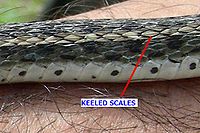 A small, slender snake, the buff striped keelback is generally olive-brown to gray in colour. The head and the body are of the same colour.
A small, slender snake, the buff striped keelback is generally olive-brown to gray in colour. The head and the body are of the same colour.
The body of the buff striped keelback is short, and it has a long slender tail which is almost a quarter of its length. Two yellow stripes along the length and to the sides of the spine are the distinctive feature of this snake. These stripes are diffuse at the head and are especially bright on the second half of its body.
The keelback has irregular blackish crossbars on the body. Near the head the crossbars are prominent, whereas on the second half of the snake they become diffuse.
The sides of the head are yellow on the head tapers to form a distinctive neck. The nape is red during the breeding season. The chin and throats are white or sometimes orange. There are black vertical markings in front of and behind the large eyes. The eyes have large round pupils with golden flecks on the iris. The forked tongue is black.
The underside is pale cream and has small black spots scattered along both the margins. It has keeled scales
.
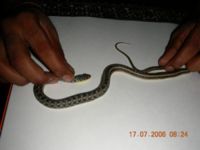 The Buff Striped keelback is usually 40 to 50 cm in length. The maximum length recorded is 90 cm. Females are consistently longer than the males which only rarely reach 620 mm (2 ft) in length.
The Buff Striped keelback is usually 40 to 50 cm in length. The maximum length recorded is 90 cm. Females are consistently longer than the males which only rarely reach 620 mm (2 ft) in length.
and Southeast Asia
. Its range extends from Pakistan
(Sindh
) to Sri Lanka
, Philippines
, India
(including the Andaman Islands
), Nepal
, Myanmar
, Thailand
, Laos
, Cambodia
, Vietnam
, Indonesia
(Borneo
, Sabah
), Taiwan
and China
(Hainan
, Hong Kong
, Fujian
, Jiangxi
).
In India, the snake is found up to an altitude of 2,000 feet.
s such as frog
s and toad
s, but they are also known to consume fish
, small lizard
s, and rodent
s.
s, tadpole
s and insect
s.
, and although mostly seen on land, it can readily take to water. It has long rear teeth for catching frogs and toads.
The buff striped keelback is nonvenomous and totally harmless. When alarmed, it inflates its body causing the bright interscale colours to be exposed. Sometimes, the snake flattens and narrows its head to form a hood. This behaviour sometimes causes the species to be mistaken by laypersons for a baby cobra.
The snake aestivates during hot weather and appears at the end of summer. It is abundant during the rains. In north India, the striped keelback hibernates
25 to 45 cm under the ground in soil, amongst grass roots.
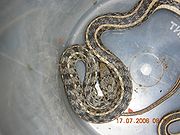
Species
In biology, a species is one of the basic units of biological classification and a taxonomic rank. A species is often defined as a group of organisms capable of interbreeding and producing fertile offspring. While in many cases this definition is adequate, more precise or differing measures are...
of nonvenomous colubrid
Colubrid
A colubrid is a member of the snake family Colubridae. This broad classification of snakes includes about two-thirds of all snake species on earth. The earliest species of the snake family date back to the Oligocene epoch. With 304 genera and 1,938 species, Colubridae is the largest snake family...
snake
Snake
Snakes are elongate, legless, carnivorous reptiles of the suborder Serpentes that can be distinguished from legless lizards by their lack of eyelids and external ears. Like all squamates, snakes are ectothermic, amniote vertebrates covered in overlapping scales...
found across Asia
Asia
Asia is the world's largest and most populous continent, located primarily in the eastern and northern hemispheres. It covers 8.7% of the Earth's total surface area and with approximately 3.879 billion people, it hosts 60% of the world's current human population...
. It is a typically nonaggressive snake that feeds on frog
Frog
Frogs are amphibians in the order Anura , formerly referred to as Salientia . Most frogs are characterized by a short body, webbed digits , protruding eyes and the absence of a tail...
s and toad
Toad
A toad is any of a number of species of amphibians in the order Anura characterized by dry, leathery skin , short legs, and snoat-like parotoid glands...
s. It belongs to the subfamily
Family (biology)
In biological classification, family is* a taxonomic rank. Other well-known ranks are life, domain, kingdom, phylum, class, order, genus, and species, with family fitting between order and genus. As for the other well-known ranks, there is the option of an immediately lower rank, indicated by the...
Natricinae
Natricinae
Natricinae is a subfamily of the colubrid family of snakes which contains 28 genera. Members of this subfamily include many very common snake species, such as the European Grass Snakes, and the North American Water Snakes.- Genera :...
, and is closely related to water snake
Water snake
Different snakes are called water snakes. Most are colubrids. "Water snake" is also sometimes used as a descriptive term for any snakes that spend a significant time in or near fresh water, such as any species belonging to the family Acrochordidae...
s and grass snakes. It pretty much resembles an Asian version of the American garter snake. It is quite a common snake but is rarey seen.
Anatomy and morphology

The body of the buff striped keelback is short, and it has a long slender tail which is almost a quarter of its length. Two yellow stripes along the length and to the sides of the spine are the distinctive feature of this snake. These stripes are diffuse at the head and are especially bright on the second half of its body.
The keelback has irregular blackish crossbars on the body. Near the head the crossbars are prominent, whereas on the second half of the snake they become diffuse.
 |
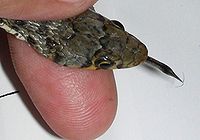 |
The sides of the head are yellow on the head tapers to form a distinctive neck. The nape is red during the breeding season. The chin and throats are white or sometimes orange. There are black vertical markings in front of and behind the large eyes. The eyes have large round pupils with golden flecks on the iris. The forked tongue is black.
The underside is pale cream and has small black spots scattered along both the margins. It has keeled scales
Keeled scales
Keeled scales refer to reptile scales that, rather than being smooth, have a ridge down the center that may or may not extend to the tip of the scale, making them rough to the touch...
.
Morphs
There are two distinct colour varieties – a typical variety, found everywhere, with grayish-blue interscale colour. The second variety, erythrostictus, is common mainly in coastal areas and has bright vermillion interscale colour. The interscale colours become visible only when the snake puffs itself up when agitated.Identifying characteristics
- The nasal shield does not touch the second supralabial (upper lip shield).
- The rostral touches a total of 6 shields. These are two inter-nasals, two nasals and the first supralabial on each side.
- Presence of single temporal shield.
- Nineteen rows of costals which are strongly keeled except for the outer row which is perfectly smooth.
- Presence of stripes.
- Ventrals 125-161.
- Anal divided.
- Subcaudals 50-85.
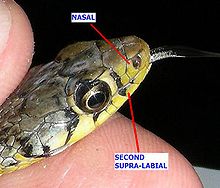 |
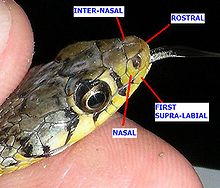 |
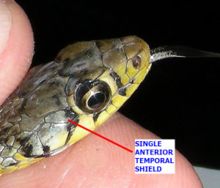 |
Size

Distribution
The buff striped keelback is found throughout SouthSouth Asia
South Asia, also known as Southern Asia, is the southern region of the Asian continent, which comprises the sub-Himalayan countries and, for some authorities , also includes the adjoining countries to the west and the east...
and Southeast Asia
Southeast Asia
Southeast Asia, South-East Asia, South East Asia or Southeastern Asia is a subregion of Asia, consisting of the countries that are geographically south of China, east of India, west of New Guinea and north of Australia. The region lies on the intersection of geological plates, with heavy seismic...
. Its range extends from Pakistan
Pakistan
Pakistan , officially the Islamic Republic of Pakistan is a sovereign state in South Asia. It has a coastline along the Arabian Sea and the Gulf of Oman in the south and is bordered by Afghanistan and Iran in the west, India in the east and China in the far northeast. In the north, Tajikistan...
(Sindh
Sindh
Sindh historically referred to as Ba'ab-ul-Islam , is one of the four provinces of Pakistan and historically is home to the Sindhi people. It is also locally known as the "Mehran". Though Muslims form the largest religious group in Sindh, a good number of Christians, Zoroastrians and Hindus can...
) to Sri Lanka
Sri Lanka
Sri Lanka, officially the Democratic Socialist Republic of Sri Lanka is a country off the southern coast of the Indian subcontinent. Known until 1972 as Ceylon , Sri Lanka is an island surrounded by the Indian Ocean, the Gulf of Mannar and the Palk Strait, and lies in the vicinity of India and the...
, Philippines
Philippines
The Philippines , officially known as the Republic of the Philippines , is a country in Southeast Asia in the western Pacific Ocean. To its north across the Luzon Strait lies Taiwan. West across the South China Sea sits Vietnam...
, India
India
India , officially the Republic of India , is a country in South Asia. It is the seventh-largest country by geographical area, the second-most populous country with over 1.2 billion people, and the most populous democracy in the world...
(including the Andaman Islands
Andaman Islands
The Andaman Islands are a group of Indian Ocean archipelagic islands in the Bay of Bengal between India to the west, and Burma , to the north and east...
), Nepal
Nepal
Nepal , officially the Federal Democratic Republic of Nepal, is a landlocked sovereign state located in South Asia. It is located in the Himalayas and bordered to the north by the People's Republic of China, and to the south, east, and west by the Republic of India...
, Myanmar
Myanmar
Burma , officially the Republic of the Union of Myanmar , is a country in Southeast Asia. Burma is bordered by China on the northeast, Laos on the east, Thailand on the southeast, Bangladesh on the west, India on the northwest, the Bay of Bengal to the southwest, and the Andaman Sea on the south....
, Thailand
Thailand
Thailand , officially the Kingdom of Thailand , formerly known as Siam , is a country located at the centre of the Indochina peninsula and Southeast Asia. It is bordered to the north by Burma and Laos, to the east by Laos and Cambodia, to the south by the Gulf of Thailand and Malaysia, and to the...
, Laos
Laos
Laos Lao: ສາທາລະນະລັດ ປະຊາທິປະໄຕ ປະຊາຊົນລາວ Sathalanalat Paxathipatai Paxaxon Lao, officially the Lao People's Democratic Republic, is a landlocked country in Southeast Asia, bordered by Burma and China to the northwest, Vietnam to the east, Cambodia to the south and Thailand to the west...
, Cambodia
Cambodia
Cambodia , officially known as the Kingdom of Cambodia, is a country located in the southern portion of the Indochina Peninsula in Southeast Asia...
, Vietnam
Vietnam
Vietnam – sometimes spelled Viet Nam , officially the Socialist Republic of Vietnam – is the easternmost country on the Indochina Peninsula in Southeast Asia. It is bordered by China to the north, Laos to the northwest, Cambodia to the southwest, and the South China Sea –...
, Indonesia
Indonesia
Indonesia , officially the Republic of Indonesia , is a country in Southeast Asia and Oceania. Indonesia is an archipelago comprising approximately 13,000 islands. It has 33 provinces with over 238 million people, and is the world's fourth most populous country. Indonesia is a republic, with an...
(Borneo
Borneo
Borneo is the third largest island in the world and is located north of Java Island, Indonesia, at the geographic centre of Maritime Southeast Asia....
, Sabah
Sabah
Sabah is one of 13 member states of Malaysia. It is located on the northern portion of the island of Borneo. It is the second largest state in the country after Sarawak, which it borders on its southwest. It also shares a border with the province of East Kalimantan of Indonesia in the south...
), Taiwan
Taiwan
Taiwan , also known, especially in the past, as Formosa , is the largest island of the same-named island group of East Asia in the western Pacific Ocean and located off the southeastern coast of mainland China. The island forms over 99% of the current territory of the Republic of China following...
and China
China
Chinese civilization may refer to:* China for more general discussion of the country.* Chinese culture* Greater China, the transnational community of ethnic Chinese.* History of China* Sinosphere, the area historically affected by Chinese culture...
(Hainan
Hainan
Hainan is the smallest province of the People's Republic of China . Although the province comprises some two hundred islands scattered among three archipelagos off the southern coast, of its land mass is Hainan Island , from which the province takes its name...
, Hong Kong
Hong Kong
Hong Kong is one of two Special Administrative Regions of the People's Republic of China , the other being Macau. A city-state situated on China's south coast and enclosed by the Pearl River Delta and South China Sea, it is renowned for its expansive skyline and deep natural harbour...
, Fujian
Fujian
' , formerly romanised as Fukien or Huguing or Foukien, is a province on the southeast coast of mainland China. Fujian is bordered by Zhejiang to the north, Jiangxi to the west, and Guangdong to the south. Taiwan lies to the east, across the Taiwan Strait...
, Jiangxi
Jiangxi
' is a southern province in the People's Republic of China. Spanning from the banks of the Yangtze River in the north into hillier areas in the south, it shares a border with Anhui to the north, Zhejiang to the northeast, Fujian to the east, Guangdong to the south, Hunan to the west, and Hubei to...
).
In India, the snake is found up to an altitude of 2,000 feet.
Conservation status
The buff striped keelback is common throughout its range, and is not of international conservation concern.Habitat
The buff striped keelback inhabits river banks, marshy areas and wetlands but is also commonly found in fields, open countrysides and overgrown grassy patches during the monsoon season.Feeding ecology
The primary diet of adult A. stolatum are small amphibianAmphibian
Amphibians , are a class of vertebrate animals including animals such as toads, frogs, caecilians, and salamanders. They are characterized as non-amniote ectothermic tetrapods...
s such as frog
Frog
Frogs are amphibians in the order Anura , formerly referred to as Salientia . Most frogs are characterized by a short body, webbed digits , protruding eyes and the absence of a tail...
s and toad
Toad
A toad is any of a number of species of amphibians in the order Anura characterized by dry, leathery skin , short legs, and snoat-like parotoid glands...
s, but they are also known to consume fish
Fish
Fish are a paraphyletic group of organisms that consist of all gill-bearing aquatic vertebrate animals that lack limbs with digits. Included in this definition are the living hagfish, lampreys, and cartilaginous and bony fish, as well as various extinct related groups...
, small lizard
Lizard
Lizards are a widespread group of squamate reptiles, with nearly 3800 species, ranging across all continents except Antarctica as well as most oceanic island chains...
s, and rodent
Rodent
Rodentia is an order of mammals also known as rodents, characterised by two continuously growing incisors in the upper and lower jaws which must be kept short by gnawing....
s.
Life history
Keelbacks are oviparous. Mating is thought to take place during the aestivation period. Gravid females have been found from April to August and eggs are laid in underground holes from May to September. The snake lays a clutch of 5 to 10 pure white eggs. Females remain with eggs till they hatch. The young snakes are 13 to 17 cm at birth and eat small frogFrog
Frogs are amphibians in the order Anura , formerly referred to as Salientia . Most frogs are characterized by a short body, webbed digits , protruding eyes and the absence of a tail...
s, tadpole
Tadpole
A tadpole or polliwog is the wholly aquatic larval stage in the life cycle of an amphibian, particularly that of a frog or toad.- Appellation :...
s and insect
Insect
Insects are a class of living creatures within the arthropods that have a chitinous exoskeleton, a three-part body , three pairs of jointed legs, compound eyes, and two antennae...
s.
Behavior
The buff striped keelback is diurnalDiurnal animal
Diurnality is a plant or animal behavior characterized by activity during the day and sleeping at night.-In animals:Animals that are not diurnal might be nocturnal or crepuscular . Many animal species are diurnal, including many mammals, insects, reptiles and birds...
, and although mostly seen on land, it can readily take to water. It has long rear teeth for catching frogs and toads.
The buff striped keelback is nonvenomous and totally harmless. When alarmed, it inflates its body causing the bright interscale colours to be exposed. Sometimes, the snake flattens and narrows its head to form a hood. This behaviour sometimes causes the species to be mistaken by laypersons for a baby cobra.
The snake aestivates during hot weather and appears at the end of summer. It is abundant during the rains. In north India, the striped keelback hibernates
Hibernation
Hibernation is a state of inactivity and metabolic depression in animals, characterized by lower body temperature, slower breathing, and lower metabolic rate. Hibernating animals conserve food, especially during winter when food supplies are limited, tapping energy reserves, body fat, at a slow rate...
25 to 45 cm under the ground in soil, amongst grass roots.
Local names

- OriyaOriya languageOriya , officially Odia from November, 2011, is an Indian language, belonging to the Indo-Aryan branch of the Indo-European language family. It is mainly spoken in the Indian states of Orissa and West Bengal...
– Halahalia saapa. - BengaliBengali languageBengali or Bangla is an eastern Indo-Aryan language. It is native to the region of eastern South Asia known as Bengal, which comprises present day Bangladesh, the Indian state of West Bengal, and parts of the Indian states of Tripura and Assam. It is written with the Bengali script...
– Hele sanp. - MarathiMarathi languageMarathi is an Indo-Aryan language spoken by the Marathi people of western and central India. It is the official language of the state of Maharashtra. There are over 68 million fluent speakers worldwide. Marathi has the fourth largest number of native speakers in India and is the fifteenth most...
– Naneti. - TeluguTelugu languageTelugu is a Central Dravidian language primarily spoken in the state of Andhra Pradesh, India, where it is an official language. It is also spoken in the neighbouring states of Chattisgarh, Karnataka, Maharashtra, Orissa and Tamil Nadu...
– Wannapam. - TamilTamil languageTamil is a Dravidian language spoken predominantly by Tamil people of the Indian subcontinent. It has official status in the Indian state of Tamil Nadu and in the Indian union territory of Pondicherry. Tamil is also an official language of Sri Lanka and Singapore...
– Nirkatan pambu. - TuluTulu languageThe Tulu language |?]]]) is a Dravidian language spoken by 1.95 million native speakers mainly in the southwest part of Indian state Karnataka known as Tulu Nadu. In India, 1.72 million people speak it as their mother tongue , increased by 10 percent over the 1991 census...
– Pageley.

